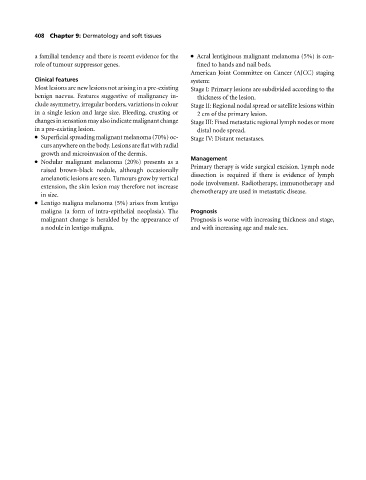Page 412 - Medicine and Surgery
P. 412
P1: FAW
BLUK007-09 BLUK007-Kendall May 12, 2005 19:59 Char Count= 0
408 Chapter 9: Dermatology and soft tissues
a familial tendency and there is recent evidence for the Acrallentiginous malignant melanoma (5%) is con-
role of tumour suppressor genes. fined to hands and nail beds.
American Joint Committee on Cancer (AJCC) staging
Clinical features system:
Most lesions are new lesions not arising in a pre-existing Stage I: Primary lesions are subdivided according to the
benign naevus. Features suggestive of malignancy in- thickness of the lesion.
clude asymmetry, irregular borders, variations in colour Stage II: Regional nodal spread or satellite lesions within
in a single lesion and large size. Bleeding, crusting or 2cmof the primary lesion.
changes in sensation may also indicate malignant change Stage III: Fixed metastatic regional lymph nodes or more
in a pre-existing lesion. distal node spread.
Superficial spreading malignant melanoma (70%) oc- Stage IV: Distant metastases.
curs anywhere on the body. Lesions are flat with radial
growth and microinvasion of the dermis.
Management
Nodular malignant melanoma (20%) presents as a
Primary therapy is wide surgical excision. Lymph node
raised brown-black nodule, although occasionally
dissection is required if there is evidence of lymph
amelanotic lesions are seen. Tumours grow by vertical
node involvement. Radiotherapy, immunotherapy and
extension, the skin lesion may therefore not increase
chemotherapy are used in metastatic disease.
in size.
Lentigo maligna melanoma (5%) arises from lentigo
maligna (a form of intra-epithelial neoplasia). The Prognosis
malignant change is heralded by the appearance of Prognosis is worse with increasing thickness and stage,
anodule in lentigo maligna. and with increasing age and male sex.

